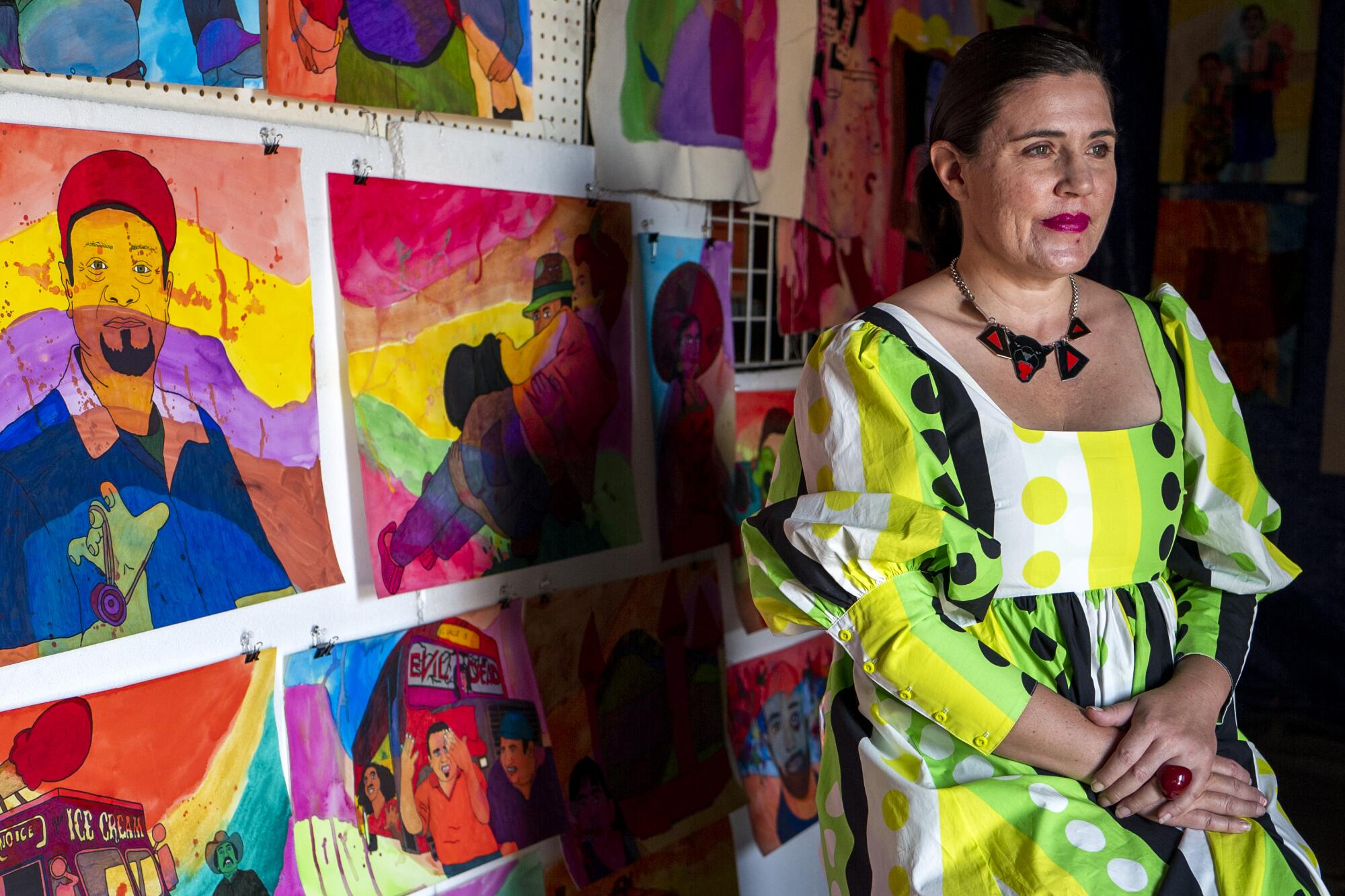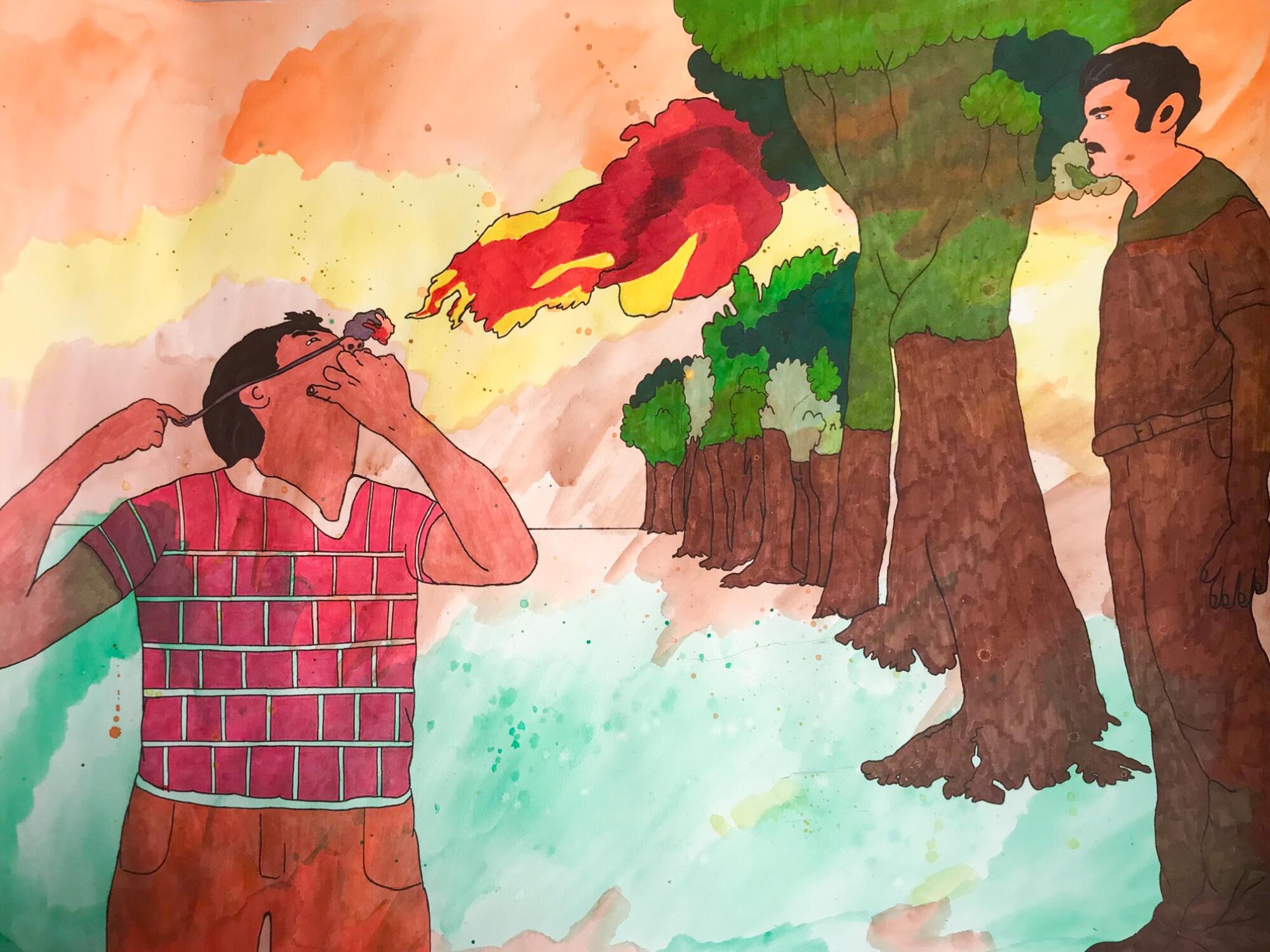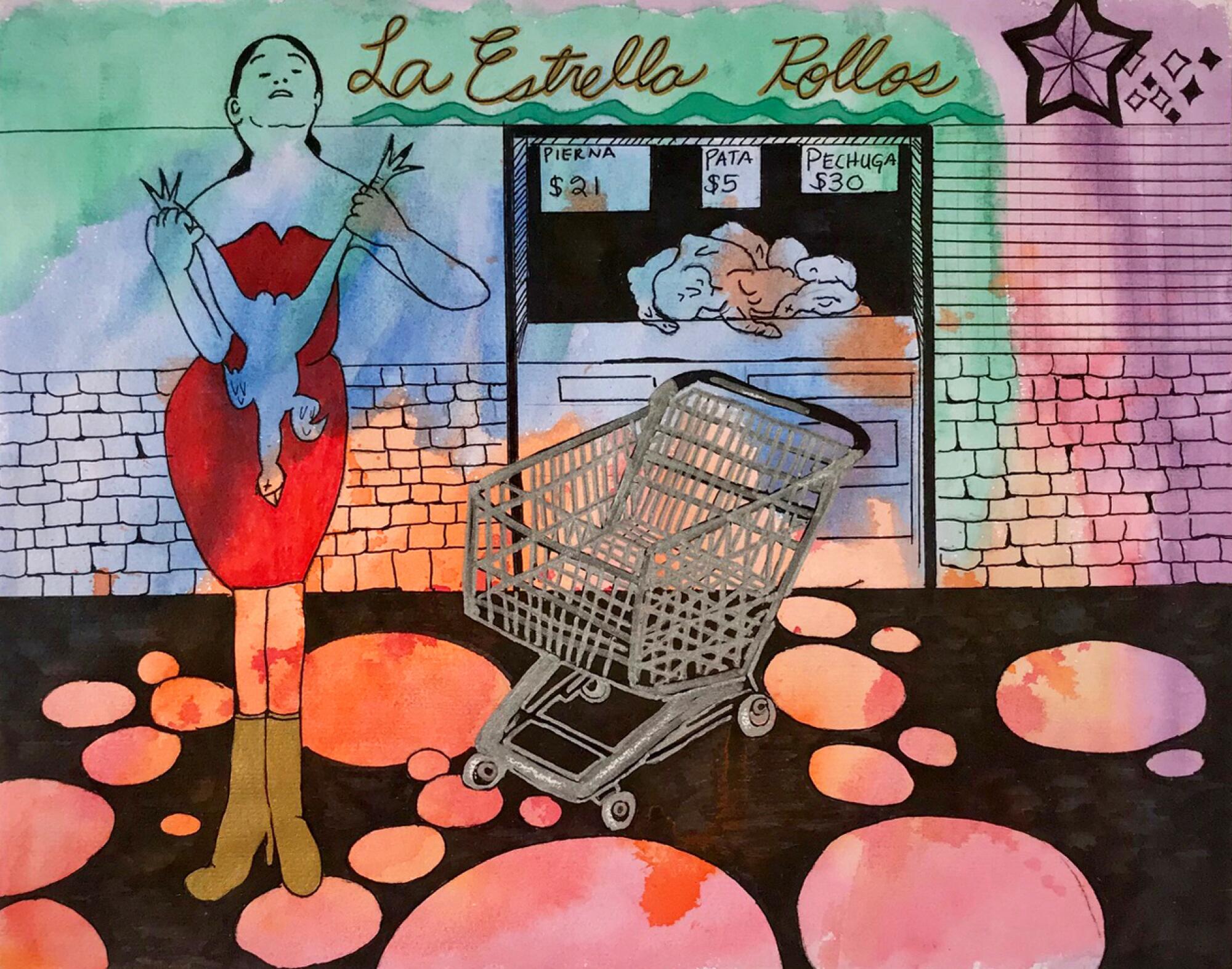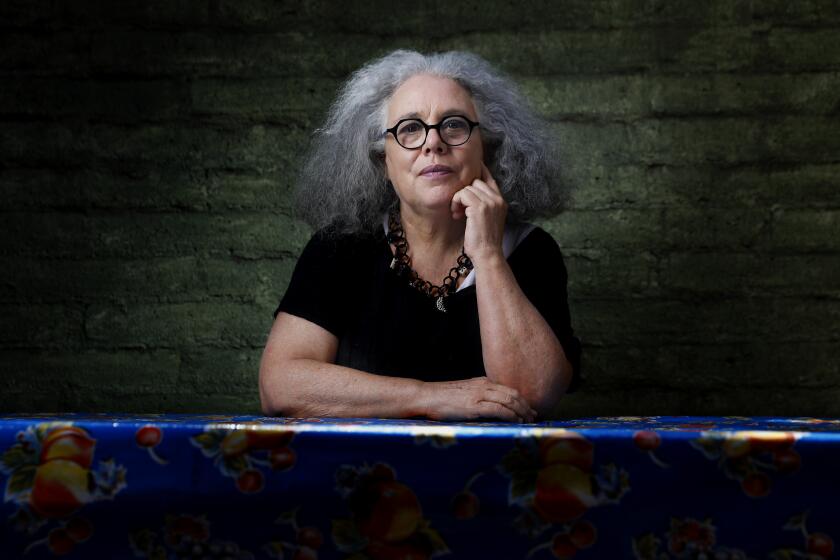
- Share via
A man dressed in brown stands before a row of trees, the color of his garments and the sturdiness of his posture evoking the solidity of the forest behind him. To his left, a fire eater spits flames into a tangerine sky.
If this all sounds like a dream, well, it is. “El ´Árbol y el Tragafuegos” — “The Tree and the Fire Eater,” in English — was painted by Los Angeles artist Karla Diaz and it emerges from her dreams and her memories. The tree-man? That’s her as a figure she once embodied in a dream. The fire eater was inspired by “Dragón,” a man — and actual fire eater — she knew from her family’s native village in the Mexican state of Colima. His real name was José and he hoped to one day become a truck driver.

Diaz is a Los Angeles artist who is perhaps better known for her works of performance and social practice.
In 2002, with fellow artist Mario Ybarra Jr. (her husband), she founded Slanguage Studio, a hybrid community arts organization/art collective that they operate out of their studio in Wilmington. That project has facilitated art making and mentoring opportunities for Los Angeles youth, who often become collaborators in residencies and curatorial projects (including an exhibition, “Possible Worlds,” held at the Los Angeles County Museum of Art in 2011).
Diaz also has worked as a performance artist with an activist bent — most notably on a long-running project titled “Prison Gourmet,” in which she re-creates some of the improvised meals put together by prison inmates from commissary foods, like a “tamale” made of crushed Cheetos. (A staging took place at the El Segundo Museum of Art in 2019.)
Review: Mario Ybarra Jr. deftly mixes reality and fiction
But her new watercolor paintings, on view through next week at Luis De Jesus Los Angeles in downtown L.A., emerge from a more intimate space.
In 2017, Diaz suffered a stroke that forced her to relearn skills that she had spent a lifetime developing. “I really had to learn how to draw and do all of that,” she says. “It took a lot of physical therapy and neurological therapy. ... It’s so devastating. You wake up and, all of a sudden, all of the years of education and everything, you have to relearn.”

The stroke also left her with a persistent case of insomnia for which she has tried just about every remedy, be it prescribed medications from her doctor or homemade concoctions recommended by friends. Frustrated by her insomnia’s persistence, she began to use the late-night hours to paint — not with the intent of manufacturing a series of museum-worthy canvases but simply to while away the hours that she was awake.
Onto pieces of white paper, she put down splashes of bright watercolor and then used these as backdrops for ink drawings that have come to serve as a surreal record of her dreams and her memories.
The artist says she has always been a vivid dreamer and has long made notes about some of the more peculiar ones. “Sometimes I’d wake up and text words to myself so I could convey the feeling or the visuals,” she says. “Like, ‘felt scared.’ Or ‘dancing folclórico.’ Or ‘I picked up a metralleta [submachine gun] and started shooting people.’”
For her insomnia paintings, she began to draw from that archive. She also began to draw from memory — of a childhood divided between Mexico and the United States, of her mother’s years-long illness that left her bedridden, of the family photos that were missing mysterious pieces, of the urban legends she heard when she lived in Boyle Heights in the 1990s. Among them: that space aliens pilot the Goodyear blimp.
That latter story is depicted to wondrous effect in the 2021 painting “Goodyear.” It shows the blimp against an apocalyptic Los Angeles sky, aliens seizing a helpless woman in a tractor beam, as police engage in a parallel seizure, arresting a young man on the street.
Diaz’s brilliant color palette is drawn from her interest in Mexican craft as well as comic books. In fact, comics were formative — she read piles of them as a kid. “I would lose myself in these stories and in these characters,” she says. “I think, for me, that was an inspiration.”

The artist says the production of her insomnia paintings is less about meticulous investigation than reveling in instinct.
She’ll start with a wash of color triggered by an emotion or a memory. “I’ll be like, ‘This color reminds of the time I used to be a kid,’ or ‘These colors remind me of my mom’ or ‘They remind me of my grandmother,’” she says. “Or maybe they remind me of eating a mango.”
From there, she will draw — quickly. “There is a blurriness to it, just like our dreams,” she says. “They are done in this immediate kind of urgent way.”
And by the time she is done, she is sleepy. “On days where I don’t do it,” she says, “it’s so crazy — I can’t sleep.”
In a two-part show, the L.A. artist empowers a stereotyped figure from American literature and conjures magic and cleansing.
What began as a way of contending with her insomnia has grown into something much deeper, allowing her to also contend with the helplessness and unease triggered by the stroke. “It’s been very cathartic in a way,” says Diaz. Late at night, she sometimes finds herself crying and laughing.
It also has freed her artistically. “I wasn’t going to share these,” she says. “It was just for me in this therapeutic space.”
But by letting go of expectation, she has found herself exploring vibrant new territory — territory that began to draw broader attention when she would post the images to Instagram (@karladiaz76).

At a 2018 solo show at the now-defunct Creative Arts Coalition to Transform Urban Space (known as CACTUS) in Long Beach, Diaz showed a series of works inspired by old family photos. The pieces consisted of portraits of family members that she stitched directly onto canvas. These were made at another moment when she was grappling with memory — that of family and lineage in the wake of her mother’s death. Based on formal portraits, those images were more removed, more aloof.
Diaz’s insomnia paintings are the opposite. Vivid, deeply saturated and wholly present, they function as a record of the rogue memories that occupy our minds and the memories (like muscle memory) we take for granted. They are at once visceral and violent, funny and bizarre, and rife with human feeling.

In this very personal gallery, she presents half-human creatures hanging out at a bar, a monument toppling, a family reckoning with the psychological effects of Mexico’s protracted narco-violence. A painting of her sick mother, “My Sleeping Beauty,” shows a resting female figure floating in a rainbow-hued sky. A feeding tube connects her body to a brilliant red flower, one of many that surround her like a halo.
“I wanted to connect that,” she says. “In the painting, she is connected to the flowers. I wanted life and death connected.”
In our pandemic time, never have life and death been so visibly linked — a condition that Diaz fluidly taps into late at night when, unable to sleep, she sits down before a blank piece of paper and renders the things we may feel but find ourselves unable to speak.
Karla Diaz: Insomnia
Where: Luis De Jesus Los Angeles, 1110 Mateo St., downtown Los Angeles
When: Through Oct. 30
Info: luisdejesus.com
More to Read
The biggest entertainment stories
Get our big stories about Hollywood, film, television, music, arts, culture and more right in your inbox as soon as they publish.
You may occasionally receive promotional content from the Los Angeles Times.













